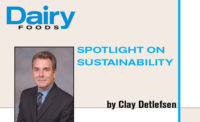Use metrics to measure sustainability efforts
Measuring sustainability practices involves many variables. There is no one-size-fits-all approach that works for all operations. Metrics take differences into consideration.

Consumers continue to demand tasty and nutritious products that are produced in an environmentally responsible way. As a result, retailers and foodservice companies have heightened interest in the sustainability of their suppliers, and environmental organizations have ratcheted up their sustainability assessments of industries and businesses.
Of course, as Saint Bernard of Clairvaux reportedly said: The road to hell is paved with good intentions. People have been touting sustainability metrics for longer than they have been able to grasp what sustainability is all about. Although those early attempts at metrics were ill-conceived, things are improving. But we have a ways to go. Before we look forward, it may help to understand a couple of examples of where past efforts went awry. With that information in hand, we can then look at the dairy industry’s own thoughtful approach to metrics.
The concept of food miles
Measuring food miles, or the distance to transport ingredients to processing and final products to market, was espoused in 1994 by the Sustainable Agriculture, Food and Environment Alliance. In “The Food Miles Report, The dangers of long-distance food transport,” the alliance espouses that a product coming from a shorter distance is greener and better for mankind because it takes less fuel to travel a shorter distance. Unfortunately, it’s not that simple.
Let’s say we wanted to offer locally grown oranges and processed juice to residents in Washington, D.C. We have the technology to make it happen, and it would require minimal fuel to move the products to local markets. Would that make it a perfectly green solution? Of course not.
Oranges are grown outside in Florida, California and South America, but that’s not an option during Washington’s cool winters. Hothouses would be needed to control the climate, meaning every drop of fuel saved by local delivery would be wasted to create and maintain an unnatural environment just to keep the food miles down.
Food miles may have been a catalyst for industries to consider their footprints, but it’s clear they are only one factor in a complex measurement system. In fact, a March 2010 U.S. Department of Agriculture Economic Research report showed that the transportation portion of food’s full energy flow (analogous to a lifecycle assessment) is the single smallest component. Choosing to eat local sourced foods is not without merit, but it must be kept in context.
Carbon footprinting and labeling
Tesco, Britain’s largest supermarket chain, decided in 2007 to require consumer goods and food products to display labels that would show how many grams of carbon dioxide or equivalent greenhouse gases were emitted as a result of growing, manufacturing, transporting and storing the products. The labels also would reflect the impact of using a product and then disposing of waste.
Although Tesco initially identified 70,000 products that manufacturers could label, the company eventually pulled the plug earlier this year because implementation was too complex and consumers found the labels difficult to understand.
A sustainability framework for dairy
The fact is that measuring sustainability practices involves many variables and requires a significant amount of science and testing. Production systems vary, and there is no one-size-fits-all approach to sustainability that works for all operations. It’s important that metrics take these differences into consideration, grounding the measurements and results in the reality of the way dairy systems operate.
To that end, the Innovation Center for U.S. Dairy has developed the “Sustainability Measurement and Reporting Framework for U.S. Dairy.” It supports the industry’s vision “to be leaders in sustainability, ensuring the health and well-being of our planet, communities, consumers and the industry.”
The approach is not to measure specific practices but overall outcomes and improvements over time. The framework is based on the Innovation Center’s lifecycle assessment research, additional scientific studies and input from experts within and outside the dairy industry. Used in conjunction with the Innovation Center’s tools — Farm Smart, Dairy Plant Smart and Dairy Fleet Smart — the framework can help dairy farms and businesses measure the impact they have on the environment and identify opportunities for improvement.
Unlike past attempts, the framework does not focus on a single attribute or factor. Its comprehensive approach identifies numerous indicators to consider on the farm and at processing locations. In phase one, processors will look at 10 environmental indicators, eight social indicators and three economic indicators. Producers will consider 13 environmental, 13 social and four economic indicators.
The farm and processing indicators include both intensity indicators, such as direct energy consumption per unit of production, and non-intensity indicators, such as the number of jobs provided, products donated or hours volunteered in the community. These indicators are the starting point; the framework will evolve and additional indicators will be included over time.
Dairy farms and businesses now will be able to measure much more accurately and then communicate effectively about the sustainability of our products. Retailers will receive consistent and credible information and consumers will be reassured that their favorite dairy foods and beverages are sustainable choices.
Perhaps we finally will succeed where others have failed. Visit USDairy.com/Sustainability for more information.
Looking for a reprint of this article?
From high-res PDFs to custom plaques, order your copy today!





